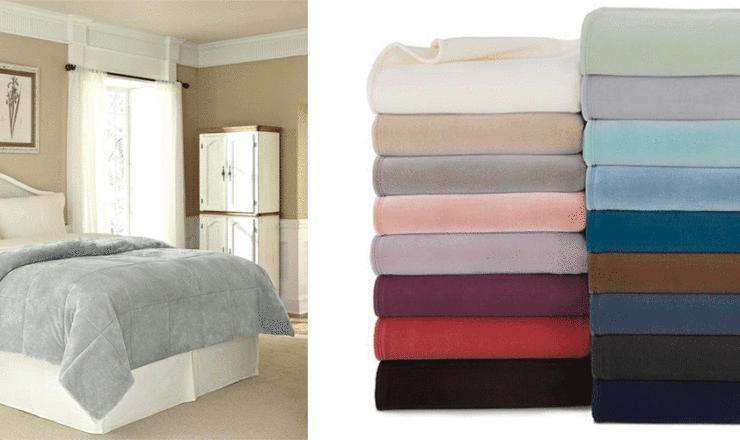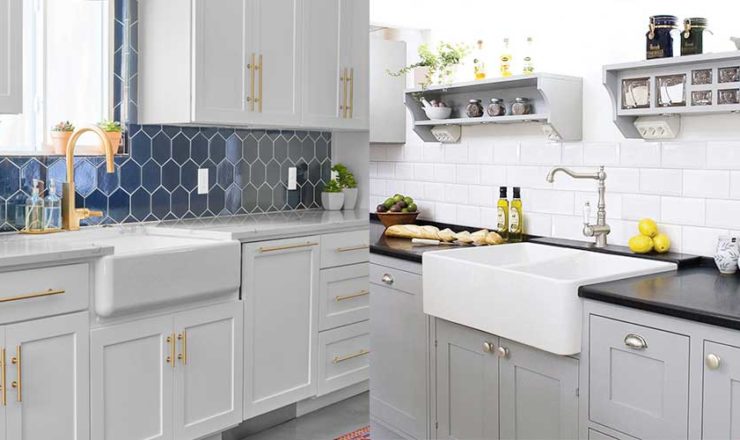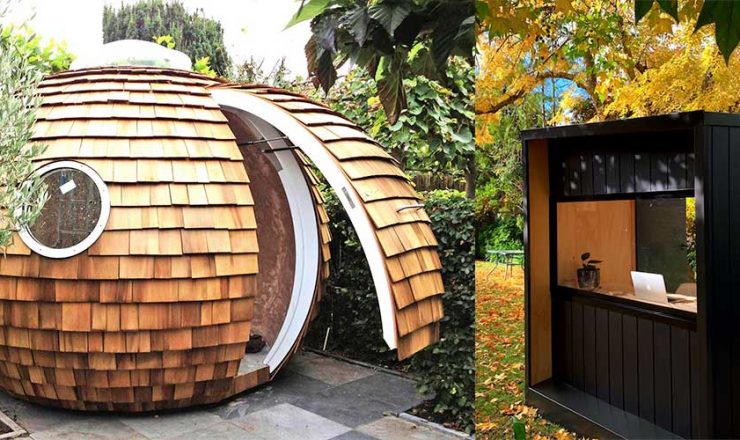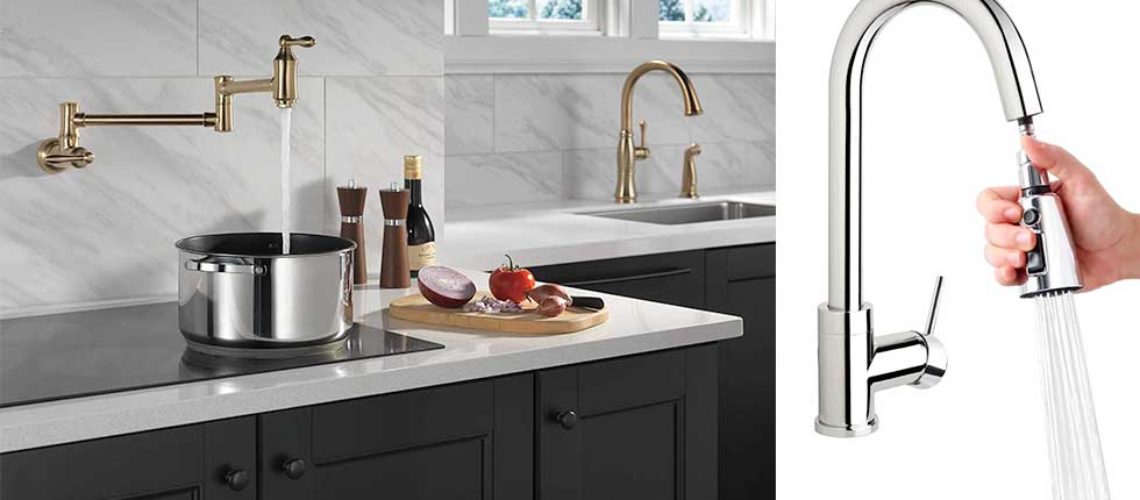
Types of Kitchen Faucets
One of the most underrated pieces of equipment in the house is the kitchen faucet.
A kitchen sink is essential to every home.
This is a good place to prepare food, cleanse fruits and vegetables, wash dirty plates and kitchenware, and so much more.
Needless to say, a kitchen without a good kitchen sink is pretty much useless.
You can make do without expensive kitchen lighting, high-tech appliances, or even branded kitchenware; but you can’t have a so-so kitchen sink.
A good kitchen sink must always have a complementary more-than-serviceable kitchen faucet.
There are countless kinds of kitchen faucets ranging from the “simple” and most common single or double-handle faucets to the restaurant-type faucet that is specifically designed to be removable for ultra flexibility.
Each type of faucet has its own unique characteristic and personality which will make (or unmake) your kitchen.
This article aims to help you choose the perfect kitchen faucet to pair with your kitchen sink.
We will guide you through the numerous choices available.
We made this presentation as organized as possible by breaking down these choices into categories (the main types, grouped according to functions, grouped according to materials, and even highlighted special features that are unique to some of the respective kitchen faucets).
This is your due diligence to make sure you pick the perfect one.
Main Types of Kitchen Faucets
1. The Pull-Down Faucet

We start with the most common kitchen faucet that you can easily find in most homes.
A simple turn of the faucet hand (or spray wand) downwards towards the sink releases the water.
This is the standard and the most primary faucet you can buy.
It is also probably the most durable as the spray wand is not subject to different angles but a simple one-turn on and one-turn off.
So if you’re looking for the safest choice, the pull-down faucet is the way to go.
2. The Pull-Out Faucet

This is somewhat similar to the pull-down faucet. The biggest difference is that the pull-out faucet can actually “pull out” in multiple angles, not just a single line (upward and downward) like the pull-down.
It can be slightly tricky to operate especially for those who are not used to this type of kitchen faucet.
3. The Single-Handle Faucet
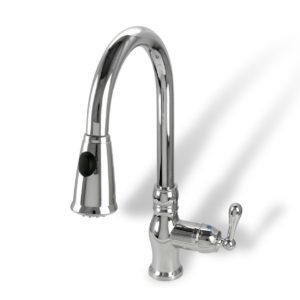
When I said that the pull-down faucet can be tricky to control, the single-handle faucet is on another level.
Whereas the pull-up only gives you regular temperature water, the single-handle faucet is designed to provide you both hot and cold water.
You have to learn how to perfectly navigate the faucet hand in going left and right to find the appropriate temperature.
And then you have to control the water pressure by pulling the hand up or down depending on the needed pressure.
For a regular kitchen faucet, this is not the one we would suggest, especially if you have young kids.
4. The Dual-Handle Faucet
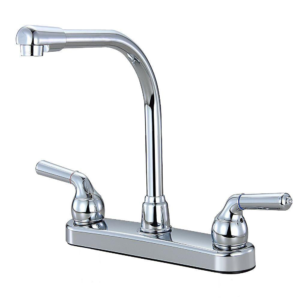
The dual-handle faucet is a slightly better option than the single-handle.
As the name suggests, there are separate handles for the hot and cold water.
This is similar to what most bathrooms would have. they can either be placed side-by-side or on either side of the faucet.
Usually, the right lever regulates the hot water and the left lever regulates the cold water.
And the water pressure is controlled by moving the two handles simultaneously either to the left or to the right of each respective lever until you get it just right.
Like the single-handle, this also needs some getting used to.
5. The Motion Detection Faucet
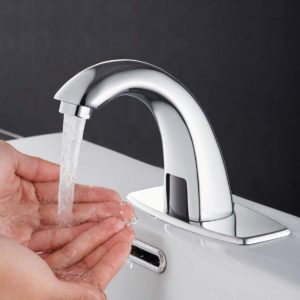
Due to the Covid pandemic, this type of faucet has gotten a lot more popular due to the safety protocols and guidelines.
This used to be found only in malls of high-end hotels or restaurants.
Now, they are everywhere and can even be installed in your house; which is probably a good idea if you typically have many visitors to your home.
The water comes out when you simply place your hands near the middle of the faucet where the sensor is usually placed.
You can easily notice it because it is usually black and will definitely stand out.
You can also control the temperature through a small lever at the base of the faucet.
Motion Detection faucets might be better off being in bathrooms rather than in the kitchen.
6. The Separate Spray Faucet

If you need to have flexibility with your kitchen faucet, then this can be a good option.
This is basically two faucets – one is like a regular pull-down faucet and the other one is a spray faucet that can be removed from its base.
Talk about versatility.
They are both connected to the same water source and the separate spray faucet will not work unless the main faucet is turned on.
Once the water is flowing from the main tap, you simply pull out the extension faucet and press the trigger to redirect the water to it.
Always be aware of where the extension faucet is aimed at, or else, a lot of things are going to be very wet.
7. The Commercial-Style Faucet
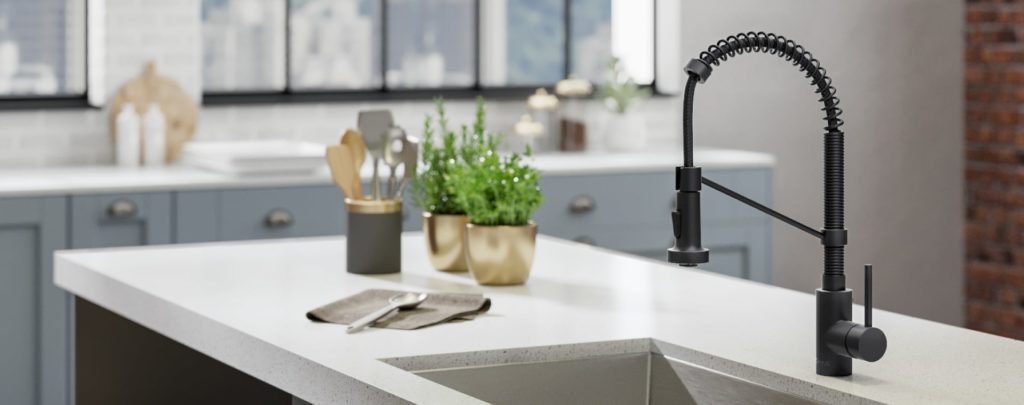
The commercial-style faucet is fundamentally an oversized separate spray faucet that we just mentioned.
The main difference is the amount of water that this type of faucet can disperse; which is, a lot!
This is heavy-duty as the name implies and can also create a more contemporary look for your kitchen.
However, this is usually utilized by restaurants and hotels and unless you are planning to wash a ton of dishes every meal, then the commercial-type faucet might not be a suitable option for you.
8. The Pot Filler Faucet
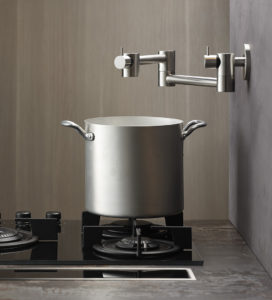
This specialized type of faucet is a preference for those that are doing a lot of cooking.
This is also usually for business purposes like the commercial-style faucet.
Some types of pot-filler faucets can even be installed directly on the wall which then connects to the water system.
You can notice it easily because it is made with a special arm extension that moves outwards as well as sideways, giving the user a wider angle for ultimate flexibility.
Faucet Parts and Uses
If you still haven’t made up your mind on what faucet to buy after going through the main types of faucets, then you must be one of those people who are very meticulous in choosing what they want. Don’t worry, we still got you covered. Read on as we discuss the different faucet parts and uses and how you can basically pick and choose and combine every individual piece.
Neck
This is the part that connects the “main” water source to the spout. Deciding which one to buy depends on your preference as the functionality is almost the same in all of them.
There are three basic types of faucet necks:
1. Standard
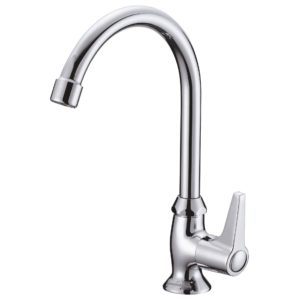
2. Bridge
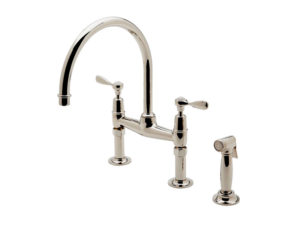
3. Gooseneck
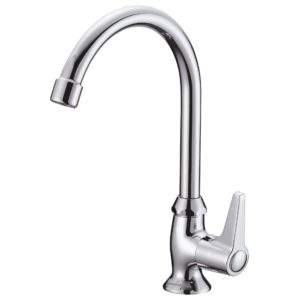
Handle
This is one of the rare easy decisions.
You either choose a faucet with only one or with two handles.
Be careful to consider all factors before you decide (i.e. you plan to have hot and cold water, easier handling versus more durable handling, etc).
Installation Type and Location
Same as the handle, the installation location has only two options to choose from.
However, this needs more than just flipping a coin to decide.
You have to coordinate with your plumber or at least someone who knows plumbing before purchasing what you want.
For example, you might want to know where the main water source is before installing a wall-mounted faucet or you might find yourself spending so much more than planned.
Deck-mounted Faucet

Wall-Mounted Faucet
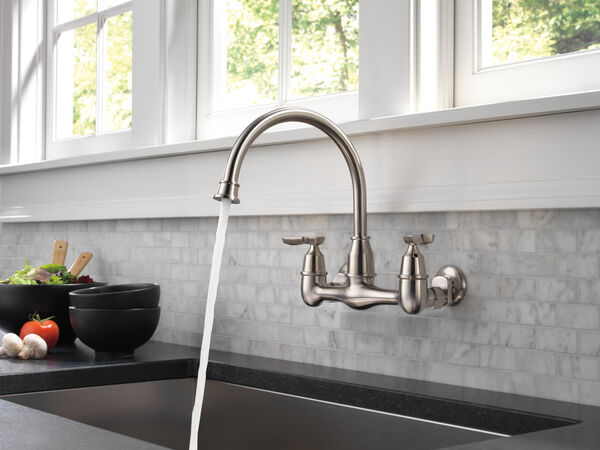
Choosing the installation type is a little more complicated.
The reason for this is because there might be certain details you would need to consider and these details might not be so easy to find.
For example, how many holes would you need to install the faucet?
Is there enough space in the sink or wall for the one you want?
What kind of countertop do you have and can it handle the installation type you will choose?
Still, don’t let this scare you.
You only need to ask for help from more experienced and knowledgeable people.
It would be worth the time and effort, guaranteed.
Materials
To state the obvious, you can customize your kitchen faucet (as well as your kitchen sink) in any way you want. Choosing the material for your faucet is no different. Simply bear in mind the overall appearance that you want for your kitchen and your decision-making will not be so difficult.
1. Plastic
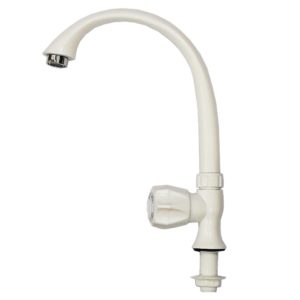
Let’s start with what is possibly the least recommended material for a faucet.
It has many advantages, for sure. It’s much cheaper, multiple color options, and can look very elegant and smooth.
Yet, the big disadvantage is durability.
If the plastic faucet chips or cracks (as is prone to happen because it is less durable than the other four types), it’s going to cost a lot to get it fixed or, quite possibly, replaced.
Another issue is compatibility with the other parts of the faucet.
Overall, not a very good option.
2. Stainless Steel
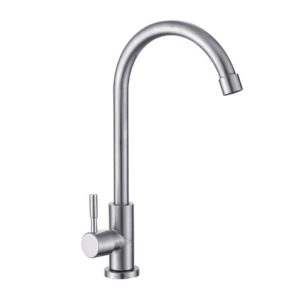
Although still not the best option in our opinion, it is leaps and bounds better than plastic.
It will blend perfectly with most kitchen sinks due to its almost flat shine and standard color.
It is easy to wash and clean to return the shininess; however, it can also scratch, therefore hard scrubbing is not recommended.
3. Zinc Alloy
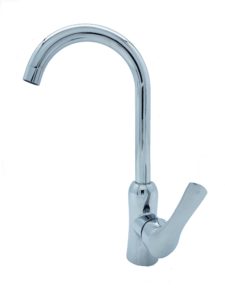
A good choice if you are looking for a long-term, rust-proof option.
A combination of copper and zinc produces a style similar to brass. One good thing about it is that it has the flexibility to be painted with other colors, as well.
It also does not deteriorate as quickly as the other types.
4. Copper
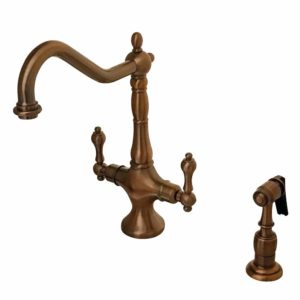
An almost majestic look due to its dark tone, you can even call it an almost fashionable rusty look.
This is not a common faucet as this is usually paired with sinks that were customized to look old or to complement classic-styled ones.
However, if you prefer copper faucets, note that this type is very light-reflective and therefore can cause a lot of reflections than what is desired.
If your kitchen is not too bright, this can work.
5. Bronze
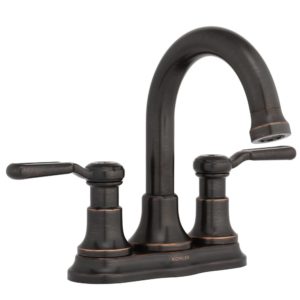
With a rustic, countryside-style, this is the most common choice for most houses.
With its darker tones, the bronze faucet releases an aura of a home that is very friendly and welcoming.
Easy on the eyes and durable, this is a good option as any when it comes to faucet materials.
The only downside is that it needs to be polished as often as possible to maintain the look.
Budget
Our world today has reached a point where if you want something, you can definitely get it if you are willing to pay the right price.
And in the world of kitchen sinks and kitchen faucets, this is no exception.
As with all other things, you have to pay for quality; yes, even for a kitchen faucet.
The standard kitchen faucet costs between $100 to $300.
The price difference depends on many factors such as materials used, the number of moving parts, and even style.
Moving up the price range are faucets that are made from more durable metals.
They typically look more elegant and refined.
Examples of these are copper or bronze faucets which can cost between $300 to $500 dollars.
Before you say, “ouch”, remember that the more expensive ones are usually more durable, more rustproof, and overall better quality.
Unless you have some plumbing background and can install it yourself, you have to dish out around $200 for an expert to do the installation.
Just for your information, here is the standard installation process:
- An important part of the process is to make sure that no hazardous materials are within the range of the location where the new faucet is to be installed. Asbestos or lead are examples of dangerous substances that shouldn’t be anywhere near a water line.
- Removing the faucet to be replaced.
- Assemble the brand-new faucet.
- Making sure everything is in the right place.
- Handling the water supply lines; this may include adding new water supply lines depending on where the new faucet is being placed
- After installing the new faucet, clean up the debris from the installation process.
The budget aspect of finding the right faucet can be somewhat discouraging; yet, the contrast between having a cheap but low-quality faucet and a high-priced but durable and stylish kitchen faucet is so worth the price difference.
Faucet Size
The first thing to do is ask where the water supply lines are so that you can estimate the size of the kitchen faucet that you will be acquiring.
If you have hot and cold water inlets, have them thoroughly checked.
They are usually about 8 inches apart but measure again, just to be sure.
The standard faucet is about 8 inches long and can stick out by around 8-12 inches from its center.
This is enough length to let it hang over the kitchen sink or basin.
If you want a longer faucet, a model of around 12-18 inches should still work especially if you have a slightly bigger kitchen sink.
Always consult an expert before customizing anything.
Unique Features
Certain special features add a combination of functionality and panache to your overall kitchen experience.
Though not essential to the basic functions, these can make your kitchen faucet easier to use.
Adjustable Stream
Typically needed by homes that require different types of water stream; whether it be the regular stream or a spray stream.
If you do more than just wash plates and prepare dinner in your kitchen sink, then you might consider adding this feature.
Adjustable Angle
This option is actually on the verge of being part of the basic faucet parts as most kitchens would need a flexible faucet for even the most common routines.
Water Flow Control Button
Usually placed near the base of the neck, this option allows you to control the amount of water that comes out of the spout as well other connected faucets or spouts.
This is particularly useful when you have a trigger spray faucet or any other faucet separate from the main spout.
Spout Swivel
Another one that could be added to the basic materials, the spout swivel allows your faucet to turn depending on the need: from 180º all the way to 360º.
Garbage Disposal Kit
This is especially helpful for those that are always in a hurry and every second count.
They can be discreetly placed on the side of the main kitchen faucet and they usually look flat and inconspicuous, which is perfect for anything related to garbage.
Built-in Water Filter
For those that are not especially picky when it comes to drinking water (i.e. tap water is fine, no need for bottled water), this is a huge money-saving option. Consider fitting it at the same time you install the main faucet to minimize additional connections.
Soap Dispenser Kit
If you need every single inch in the kitchen faucet and sink area, the soap dispenser kit is a great feature to have. Plus, it can literally match the color and style of whatever type of faucet you choose to install.
Online Shops for Kitchen Faucets
Of course, we can’t finish this part of the buying guide without including the stores you can get these from.
We recommend you see the faucets in person so that there are no surprises.
However, due to the pandemic, a lot of people would prefer to shop online.
FAQs (Frequently Asked Questions)
What are the sizes of a standard kitchen faucet?
The global standard for all kitchen faucet hole sizes is 1 3/8 inches (English system) or 35mm (Metric system).
The regular faucets have either one or three holes.
For single-handle faucets, a single hole is used.
However, for faucets that have hot and cold handles, three holes are needed, including one for the main faucet.
If you are using the three-holed faucet, be sure to verify the sizes before buying a replacement.
The standard separation distance for the two holes is 8 inches but it won’t hurt to double-check.
The three most important measurements to take are:
- The current number of holes in the countertop;
- The distance between the holes, if needed;
- The thickness of the countertop to make sure you buy the perfect size.
An important thing to note is that if you make a mistake in buying the faucet and choosing one that has a different number of holes than what is actually needed, you don’t necessarily have to return it.
You can use escutcheons or small metal plates to cover extra holes.
Or you can drill additional holes if needed. Of course, this is extra work and returning it might be the best solution, after all.
What materials are kitchen faucets made of?
Most home kitchen faucets are made of brass. Lately, though, die-cast zine and even chrome-plated plastic faucets have gained so much popularity due to their cheap price, not necessarily because it’s better quality.
The metal or plastic ones are mostly found in single-handle faucets which are the cheapest ones.
Again, these are cheap because quality-wise, they’re not the best, to say the least.
The die-cast zinc is somewhat more durable but it is nowhere near the quality of brass faucets.
If you need more details, you can go back to the top of this article to see more detailed descriptions.
Can kitchen faucets be painted?
Yes, most kitchen faucets can be painted (or repainted, in some cases).
Metal faucets are the easiest to paint over and the plastic ones can also be painted but with a special kind of paint for this type of material.
For metal and plastic, a primer should be used first before applying the main color.
An interesting thing to note is that it is much better to use spray paint in this case than a paintbrush.
Make sure you buy paint (primer and main) that works on the type of surface you are covering.
Also, another good idea is to cover the immediate surroundings to prevent accidental spillage.
As the area you are painting is small, there is no need to stop work in the other areas of the kitchen while painting.
You can even paint the faucet while it is attached to the base so there is no need for plumbing work here.
Although remember not to use the faucet while the paint is still wet.
And even better, make a note to remind everyone especially if you have kids and teenagers.
Can kitchen faucets be repaired?
Absolutely. Almost all kitchen faucets can be repaired but bear in mind that in some cases, it is almost more practical to replace the whole faucet than to fix them.
In single-handle faucets, however, it is important to know what type it is before doing the repairs:
- Ceramic Disc
- Cartridge
- Ball
Unless you want to spend more money having a plumber coming over to fix it, you have to learn some basic DIYs.
It’s easy enough to remove the faucet and bringing it with you to the hardware store.
Take lots of pictures before and after removing the faucet so that the hardware store person can correctly assess the situation.
Also, do the same after installing the new faucet for documentation purposes just in case there is a problem only a few days after the new installation.
How long do kitchen faucets last?
This can depend on a myriad of factors: the number of times used, faucet materials, installation process, and faucet type are some of the biggest contributors to the lifespan of the faucet.
Most faucets don’t need to be repaired or replaced for well over 10 years; with some reaching 15 to 20 years.
The more well-known brands even give a lifetime warranty.
And if there are ever repairs needed earlier than 10 years, they might be minor issues like a loose nut or a broken washer.
This can be repaired and replaced pretty easily.
How do kitchen faucets work?
Almost all homes, especially in urban areas, the city or town provides a pressurized water supply.
This means that the faucet is basically a stopper that prevents the water from spurting out from the main water supply.
Technically, the faucet acts as a water regulator, especially in single-handle units.
Lifting the handle releases the water supply, and closing it restricts the water from coming out.
It’s that simple, really. For dual-handles, the logic is still the same except that the water supply goes through two separate smaller outlets.
Can kitchen faucets be recycled? If so, how?
For those that are environmentally conscious, yes, the metal kitchen faucets can be recycled.
These include zinc and even brass ones.
However, plastic faucets are not as recyclable because of their basic compounds which can be toxic.
Although, because you would only need to replace them every 15-20 years, it is not really a big issue.
There are a lot of recycling centers around and you wouldn’t need to look far to find them.
Which kitchen faucets are popular?
Most of the popular kitchen faucets nowadays have multi-functioning handles that are far and above the standard kitchen faucets.
These special features might include instant hot water for hot drinks, touch-less or motion-detecting faucets, and some even have the ability to adjust the water pressure quite easily.
One popular brand is the Delta’s Leland Single-Handle Arctic Stainless Faucet 9178-AR-DST.
It is very useful for those that need flexibility and more length to their faucet as the spout can actually detach and become a spray hose.
It has a MagnaTite Docking technology that uses magnets to attach the spray to the main faucet and does not lose its power quickly like others with similar features.
It also covers fingerprints very well due to its matte silver surface.
Another one you might want to look at is the Moen 7594EC Arbor Motionsense Touchless Pulldown Kitchen Faucet.
With its two-sensor technology, it detects and analyzes your needs and provides an adequate water supply.
It provides more 50% more spray power than other comparable brands.
It can be installed in multiple different ways due to its adjustable hole layout.
The finish is elegant and belongs in any type of kitchen sink.

